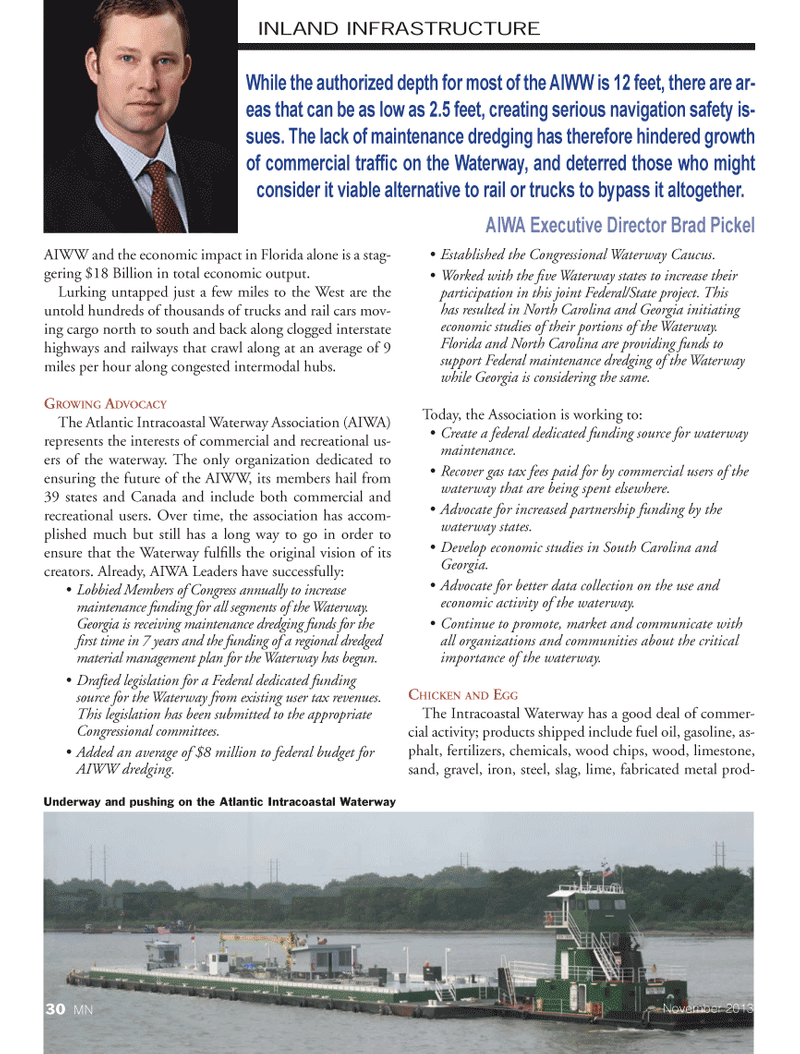
Page 30: of Marine News Magazine (November 2013)
Fleet Optimization Roundtable
Read this page in Pdf, Flash or Html5 edition of November 2013 Marine News Magazine
AIWW and the economic impact in Florida alone is a stag- gering $18 Billion in total economic output. Lurking untapped just a few miles to the West are the untold hundreds of thousands of trucks and rail cars mov- ing cargo north to south and back along clogged interstate highways and railways that crawl along at an average of 9 miles per hour along congested intermodal hubs. GROWING ADVOCACY The Atlantic Intracoastal Waterway Association (AIWA) represents the interests of commercial and recreational us- ers of the waterway. The only organization dedicated to ensuring the future of the AIWW, its members hail from 39 states and Canada and include both commercial and recreational users. Over time, the association has accom- plished much but still has a long way to go in order to ensure that the Waterway fulÞ lls the original vision of its creators. Already, AIWA Leaders have successfully: Lobbied Members of Congress annually to increase maintenance funding for all segments of the Waterway. Georgia is receiving maintenance dredging funds for the rst time in 7 years and the funding of a regional dredged material management plan for the Waterway has begun. Drafted legislation for a Federal dedicated funding source for the Waterway from existing user tax revenues. This legislation has been submitted to the appropriate Congressional committees. Added an average of $8 million to federal budget for AIWW dredging. Established the Congressional Waterway Caucus. Worked with the ve Waterway states to increase their participation in this joint Federal/State project. This has resulted in North Carolina and Georgia initiating economic studies of their portions of the Waterway. Florida and North Carolina are providing funds to support Federal maintenance dredging of the Waterway while Georgia is considering the same. Today, the Association is working to: Create a federal dedicated funding source for waterway maintenance. Recover gas tax fees paid for by commercial users of the waterway that are being spent elsewhere. Advocate for increased partnership funding by the waterway states. Develop economic studies in South Carolina and Georgia. Advocate for better data collection on the use and economic activity of the waterway. Continue to promote, market and communicate with all organizations and communities about the critical importance of the waterway. CHICKEN AND EGGThe Intracoastal Waterway has a good deal of commer- cial activity; products shipped include fuel oil, gasoline, as- phalt, fertilizers, chemicals, wood chips, wood, limestone, sand, gravel, iron, steel, slag, lime, fabricated metal prod- INLAND INFRASTRUCTUREWhile the authorized depth for most of the AIWW is 12 feet, there are ar- eas that can be as low as 2.5 feet, creating serious navigation safety is-sues. The lack of maintenance dredging has therefore hindered growth of commercial trafÞ c on the Waterway, and deterred those who might consider it viable alternative to rail or trucks to bypass it altogether. AIWA Executive Director Brad Pickel Underway and pushing on the Atlantic Intracoastal Waterway November 201330 MNMN November2013 Layout 18-31.indd 30MN November2013 Layout 18-31.indd 3010/28/2013 3:15:26 PM10/28/2013 3:15:26 PM

 29
29

 31
31
